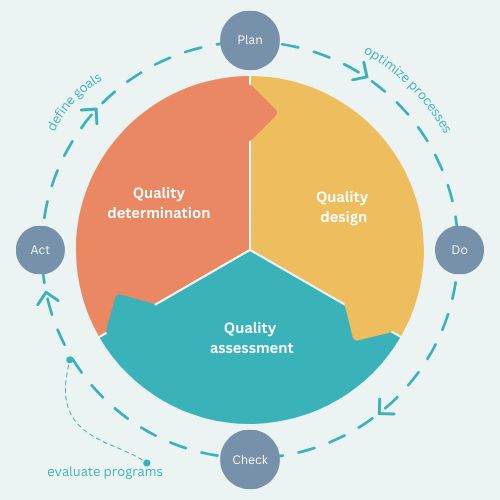Approach

For us, quality means the successful combination of interlocking factors that contribute to achieving the goals of studying and teaching at OVGU. We are aware that only selected individual characteristics can be controlled, but that “holistic quality” cannot be controlled directly. In order to grasp the degree of complexity in the process of quality development, we have reduced our model to factors that can be intervened.
The basis for ensuring and developing quality is formed by the quality-relevant processes in the area of teaching and learning.
The processes are embedded in a quality control loop - based on the Plan-Do-Check-Act control loop or Deming Cycle (according to William Edwards Deming).
Our approach to systematic and strategic quality development at OVGU is cyclical and is divided into three phases:
- Quality determination,
- quality design and
- quality assessment.
The starting point of a development cycle is therefore the quality determination phase.
At the university level, the university management - in dialog with the faculties and student representatives - defines the goals and priorities in studying and teaching at a normative (and strategic) level.
- What do we want in teaching and learning at OVGU?
- How do we want to achieve this?
- How do we recognize whether we have done this well?
- How do we change and develop in the process?
In this phase, faculty-specific quality objectives are also developed and adjusted at faculty level in coordination with the overall university objectives and the strategic orientation of the university management.
Quality design
In this phase, we support projects at faculty level to develop and safeguard the quality of studies and teaching and accompany the further development of study programs.
In addition, as the OVGU's central quality officers (ZQBs), we from the Quality Assurance Department identify further development potential within the core processes of studying and teaching and initiate projects to further optimize quality in the respective process areas. The priorities set by the university management as well as internal and external reviews, internal data reporting, the requirements and recommendations of accreditation procedures and current developments in higher education policy guide their actions.
Quality assessment
Based on a clear definition of objectives, the achievement of objectives, failure to achieve objectives, conflicts of objectives or unplanned quality of results can be measured following the respective development steps. Our evidence-based approach to quality development gives us the opportunity to review and reflect on the degree of target achievement in a standardized and context-related manner and to derive impulses for further development. For this purpose, a condensed evaluation concept is developed at the level of the university.

